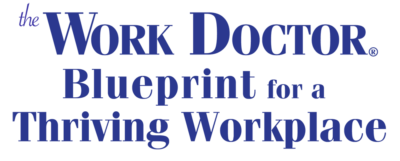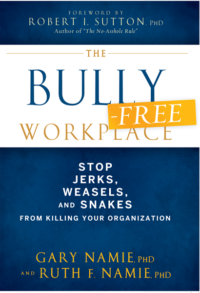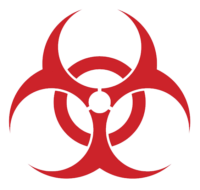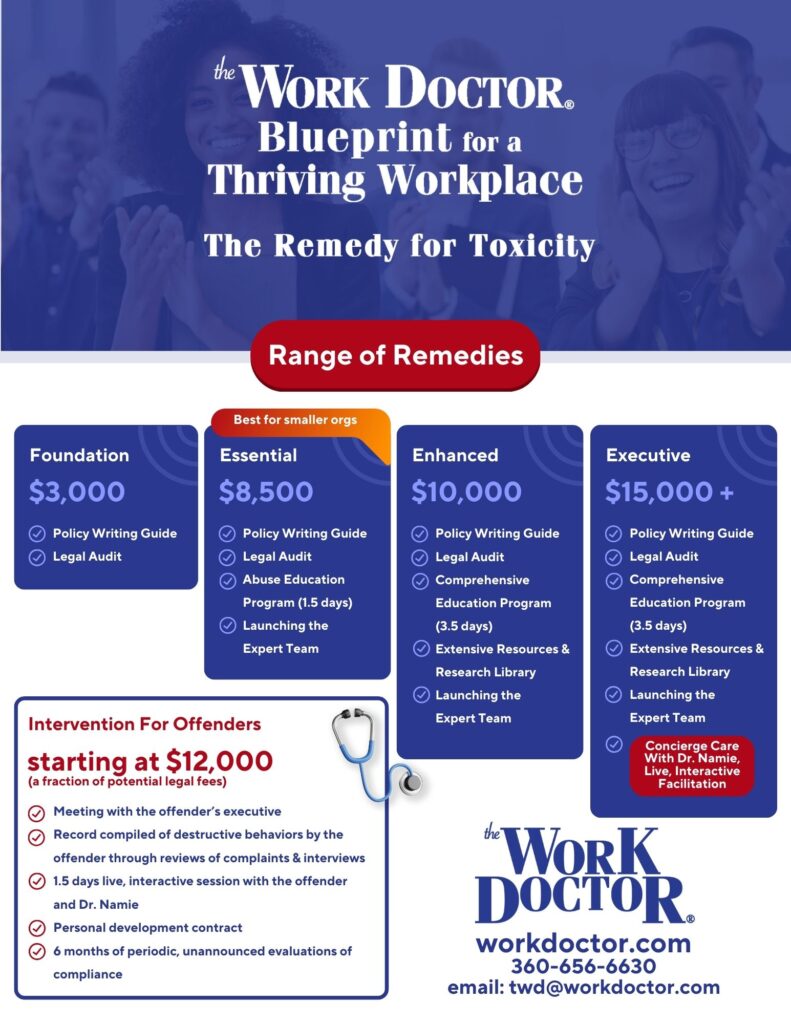Thriving is the opposite of toxicity
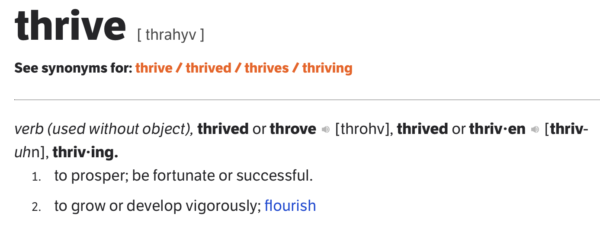
Thriving means to flourish in every way, including prosperity!
Younger generations were taught to not tolerate abusive conduct, first in school and now in workplaces. Gen Z workers are not willing to “pay their dues, keep their heads down, and accept whatever is done to them.” Toxic Boomer-designed workplaces no longer attract and retain workers. They are historical relics. Employers necessarily have to adjust to incoming workers. Agility is requisite.
We love to partner with bold, proactive client organizations that want to intentionally engineer their workplace cultures to maximize productivity (and profits) while simultaneously orchestrating positive social relationships among (retained) employees that younger workers demand. Our Blueprint services are Gen Z-ready!
Are you that agile organization?
Thriving is aspirational, striving to do more for your organization and people. To thrive is to not settle for the ordinary or uninspired.
The norms, expectations, values and actual operations in a thriving workplace culture are also much different than the default cultures. Only principle-driven properties foster employee engagement and innovation.
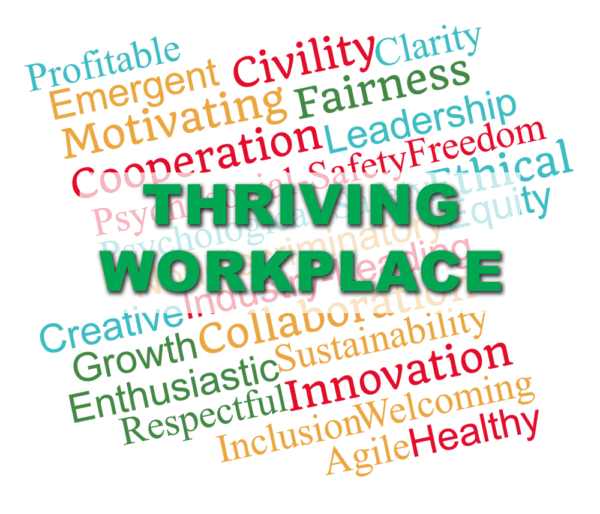
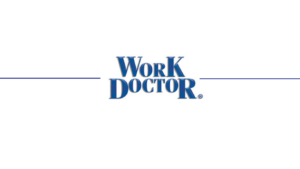

Have the courage to act?
To lead, not follow, or to not wait for a law to compel action?
Why you want to be an early adopter, not the last, to ensure a Thriving Workplace culture:
- 73% of job seekers want a workplace culture aligned with their personal values
- maximize production & profitability
- recruit & retain Gen Z workers for now and the future
- optimize employee engagement
- attract highly skilled professionals
- minimize talent flight, turnover
Craft your workplace culture to counter all behaviors in the Toxic Spectrum described here.
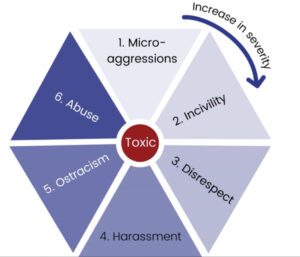
Use our Blueprint to design your culture with these Thriving properties, replacing symptoms of a toxic workplace:
- No Abuse & Focus on Safety (vs. Injurious Abuse,Bullying & Inadvertent Endangerment)
- Inclusion (vs. Ostracism, Shunning & Minimal Nondiscrimination Legal Compliance)
- Ethical Leadership & Accountability (vs. Laissez-Faire Leaders & Inconsistent Policy Enforcement)
- Respect (vs. Dehumanizing Disrespect & Contempt)
- Collaboration (vs. Incivility & Destructive Competition)
- Kindness (vs. Implicit Aggression & Hostility)

Ban Abusive Conduct, Bullying & Focus on Safety
Constrain Abuse for Maximum Impact
- Abusive conduct is repeated, harmful mistreatment of an employee by one or more employees that takes the form of verbal abuse, threats, intimidation, humiliation, work sabotage or some combination of these forms of non-physical workplace violence.
- According to the U.S. national scientific survey, 30% of workers experience it directly, another 19% witness it.
- It injures workers by inflicting stress-related diseases and impairs mental health.
- Research: when there are multiple negative workplace conditions present, abusive conduct is the most injurious. Addressing it is how to reverse toxicity most effectively.
- Mitigate abuse. Maximize leverage for positive change.
Instill a “Culture of Safety”
- In the U.S., employer attention to only the physical safety of workers satisfies the legal obligation, a minimalist approach.
- In Thriving Workplaces, employers ensure employees’ psychological safety. It is the freedom to dissent, to offer alternative, perhaps unpopular, viewpoints without fear of retaliation. Research shows it is requisite for innovation and creativity.
- The international 2021 Global Standard ISO 45003 addresses psychosocial hazards. The Standard supplements traditional work conditions with social factors (e.g., interpersonal relationships, leadership, organizational culture, civility, bullying). Psychosocial safety is the freedom to work without risk of emotional injury from emotional abuse.
- Thriving Workplaces promote a “culture of safety” (the term used by JCAHO referring to psychological safety in hospitals and healthcare) that goes beyond mere compliance.
HR Morning podcast Wipe Out Workplace Bullying: How HR Can Make It Happen
Hosted by Berta Aldrich, consultant & author of Winning the Talent Shift: Three Steps to Unleashing the New High Performance Workplace.
Guests: Dr. Gary Namie & Law Professor David C. Yamada

Inclusion
Practice nondiscrimination beyond legal compliance
- Discrimination & harassment, in the context of legally actionable misconduct, trigger law-compliant policies, complaints, investigations, lawsuits & defense costs. But discrimination can refer to differential treatment of one person compared to that given to another and be legal. It is different but the reason is not EEO-protected status group membership. It is “status-blind” harassment.
- We humans have a fundamental need to belong to groups. Groups and individuals thwart that need through exclusion and scapegoating (treating the person as a threatening “outsider”). Upon closer examination, there is no justifiable rationale for exclusion other than biases, stereotyping & irrational fear of people somehow defined as different than themselves.
- Ostracism & shunning — tools used to exclude — harm the mental health, & crush the souls, of rejected individuals. Entire classes of people considered “protected” by law are ostracized at disproportionately higher rates.
- Employers must go beyond legal compliance. Smart employers identify & stop the much more prevalent (research shows up to 4 times more common, but “legal,”) forms of social exclusion that undermine team productivity and cohesion.
- Thriving workplaces accept people for the talents they bring to the organization. The culture is welcoming, tolerant, empathic & non-exclusionary. It is inclusive. The Work Doctor Blueprint delivers the needed education & Team-driven process to ensure inclusion.


Ethical Leadership & Accountability
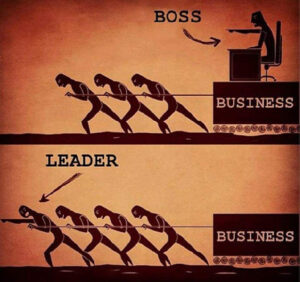
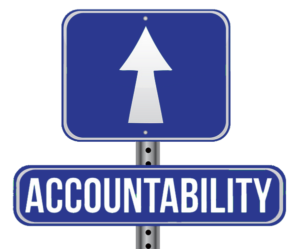
Ethical leaders sought
- Moral leaders make decisions that exceed compliance with laws. Their decisions have positive consequences for both the organization and its people. They do “the right thing.”
- Laissez-faire style disengaged executives, research shows, lack the empathic bond with non-supervisory employees while authorizing abusive conduct perpetrated by managers and supervisors.
- The best executives are confident in their own competence, share power, grant autonomy to subordinates, have strong egos without resorting to narcissism, and generously invite and appreciate participation by others in decision making.
- They are kind, not cruel, not psychopathic-like.
Accountability expected
- Traditionally, abusive perpetrators suffer no consequences for their misdeeds. This is impunity, witnessed by (disgusted) staff, perceived as injustice.
- In Thriving Workplaces, misconduct is followed by corrective action. Perpetrators have to take personal responsibility for their behavior. This is accountability.
- Accountability is accomplished by the faithful enforcement of codes of conduct and policies, consistently applied regardless of rank or favoritism.
- If injured at work, every effort is made to make the person “whole.”
- The company can do well by doing good! 90% of CEOs polled see the inverse relationship between a toxic work environment and financial performance.

Respect for All
- Disrespect directed from one person to another is an act of contempt. The actions, values, beliefs, opinions, skills & knowledge of the targeted person are denied or discounted. This marginalizes the person and suggests to coworkers that they also demonstrate disrespect.
- Disrespect is personalized dehumanization with perpetrators believing themselves superior (characteristic of narcissists) to those they deem “inferior,” thus not having earned the right to humane treatment. The decision to target some, not all, personalizes the process. Thus, the admonition to targeted people to “not take it personally” is wrong.
- Disrespect is antisocial and interpersonal aggression. It is part of abusive conduct. Alone, disrespect is not as severe as abuse.
- Disrespect triggers the onset of health harm for the targeted person. Additionally, self-doubt and the erosion of confidence impair performance.
- The organization needs to address requisite public respect among staff in Policy (as led by our Policy Writing Guide, part of Blueprint services).
- In Thriving workplaces, equality is an observable, practiced behavior. Respect assumes that people have inherent dignity and need not “earn” it. Equal treatment is respectful conduct. No one should be allowed to dominate another person while on company time. [An important part of our Intervention for Offenders, Respectful Conduct Clinic, is to demand equality of treatment for all others, regardless of privately held attitudes toward others.]


Collaboration
Address low-intensity incivility
- Incivility is a 3-part phenomenon — norm violation, ambiguous intent & low intensity antisocial behavior.
- A person is considered uncivil if refusing to act in ways consistent with “the way we (coworkers) do things here.” Persistent incivility triggers group pressure to conform to normative, expected behavior, leading to rejection, if unsuccessful. Some consider themselves simply rebellious individuals. But workplaces are social systems where the varied needs of many individuals have to be met.
- Norms are unwritten, implicit behavioral codes. Codes of Conduct and Policies make norms explicit.
- It is rude to be uncivil, from the group’s perspective. Is it intentional? Motive is difficult to discern. The disruptive nature of behaviors matters more than motives driving them.
- On our continuum of toxic behaviors under the umbrella (the Toxic 6) and from empirical research, we know incivility is less severe and of a lower intensity than either discriminatory misconduct/harassment and bullying/abusive conduct.
- Incivility creates problems for individuals who endure mundane indignities over a prolonged period that, in turn, lead to stress-related health consequences. Absenteeism, disengagement, and eventual resignation can result.
- In Thriving Workplaces, small interpersonal differences do not fester unabated. Expectations are fairly determined, then explicitly and clearly communicated. It makes consensus, not division or rebellious independence, the operating norm.
Recognize & replace destructive competition with coordination
- Marketplace success confirms the effectiveness of your competitive strategy. Competition itself is not negative.
- When interpersonal domination is the goal, competition among staff is destructive. It’s harmful to people & the organization. This competition is zero-sum, winner-take-all, an enemy-obliteration style. Winning is only attained at others’ expense. It is organizational sabotage.
- Abusers use zero-sum to undermine coworkers and subordinates, in turn, to create false perceptions by higher-ups of their “indispensability.” It is a behavioral pattern difficult to detect.
- To foster collaboration, the antithesis of destructive competition, design projects that require coordination by many to complete. Include monitoring systems that accurately capture the quality of contributions of each person, disrupting sabotage & stealing of credit.
- Our Blueprint for a Thriving Workplace is driven by an internal Team trained to serve the organization. Team members become ambassadors, exemplars of collaboration and teamwork.



Kindness

- Recall that Micro-aggressions were the starting point of negative conduct on our continuum ending in harmful Abusive conduct. It is assumed that the accidental or inadvertent blurting out of offensive comments or commission of negative actions without perpetrator awareness are the result of implicit biases & stereotypes. When first reported, offenders need to take responsibility, whether or not the acts were intentional.
- Individuals vary in emotional intelligence (EI) determining their ability to anticipate & interpret the impact of their actions on others. But lack of EI cannot rationalize that lack of self-control with coworkers. The new Policy should address the full spectrum of toxic behaviors, including the least harmful ones, in the spirit of prevention of escalation.
- Declare unacceptable any hostility directed by an employee against other employees. Do not confuse this prohibition with a “be nice” mandate. Niceness is defined as ignorance. However, to conduct oneself at work in a non-hostile manner is a legitimate mandate organizations can impose on everyone, regardless of rank.
- Finally, consider the “L” word. Employers vainly proclaim their workplace is “family.” Too often that family behaves like a toxic, alcoholic, dysfunctional family. It’s a dangerous place. In an alternative universe, it’s possible to love one’s job for its intrinsic rewards, to love one’s coworkers for the empathic validation they give to us as human beings, and to love the comfort of an employer-provided safe & secure environment.
- That alternative is doable. It’s only done by choice, only accomplished through deliberate employer action. By you!


